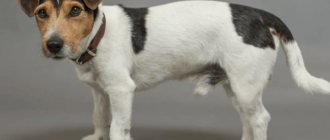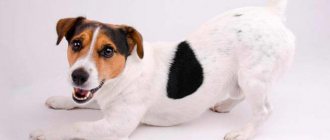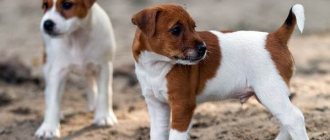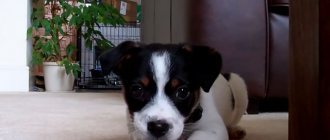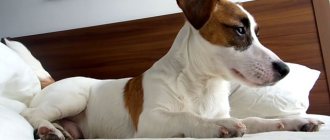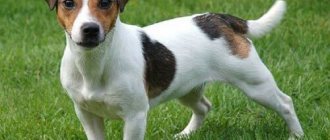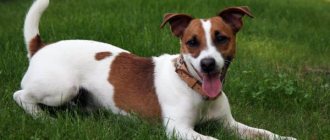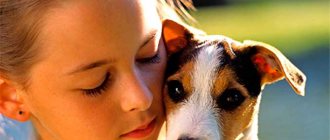| Aggressiveness |
| Upbringing |
| Training |
| Intelligence |
| Shedding |
| Behavior with children |
| Watchman |
| Security guard |
| Difficult to care for |
| Endurance in the cold |
| Endurance in the heat |
| England | |
| Lifespan | 15−18 years old |
| Height male | 25–30 cm |
| Rising bitch | 25–30 cm |
| Weight male | 5-8 kg |
| Weight bitch | 5–8 kg |
The big soul of a hunter in a miniature format – this is how you can call a Jack Russell Terrier dog. Small pets require a lot of attention and are not at all comparable to their size. It’s hard to imagine that 6 kg (that’s how much an adult dog of the breed weighs) can hide unbridled curiosity, activity and a love of adventure.
Dogs of the breed also managed to be noted in the Guineas Book of Records. In 2000, the Jack Russell terrier Part-Ex became the most extreme dog, sharing his owner's hobbies of coastering, kayaking, surfing and rock jumping.
Jack Russell Terrier puppies, and then adult dogs, are real springs and have amazing jumping ability. The terrier, not afraid of heights, can jump from its owner's shoulder, and can also jump over a fence in the garden.
The breed belongs to group 3 “Terriers” in the ICF classification, to section 2 “Small terriers”.
Breed characteristics
| Short description | |
| Origin: | England, Devonshire |
| Conditions of detention: | In an apartment, in a house without a garden, in a house with a garden |
| Purpose: | Hunting, guard |
| Color: | White with dark brown, light brown or black spots |
| Wool length: | Short 2 – 3 cm, in some varieties long 7 – 8 cm |
| Adult dog size: | The height of females is 23 - 25 cm, the height of males is 25 - 30 cm. The weight of females is approximately 6 - 7 kg, the weight of males is approximately 7 - 8 kg |
| Average life expectancy: | 15 years |
| Walk: | Needed, 2 times a day |
| Physical activity needs: | High physical activity needs (regular or daily exercise for more than 3 hours per day) |
| Fédération Cynologique Internationale (FIC) classification: | Group 3 Terriers; Section 2 small terriers |
| Puppy price: | 30,000 rubles |
Color variations
The breed standard provides for 3 color options (shown in the photo):
- white fur with red spots;
- white coat with black spots;
- white coat with black and red spots (tricolor);
- pure white coat, but this color is extremely rare.
Red color can have any intensity, from the lightest to chestnut.
History of the origin of the species
The Jack Russell Terrier breed is on everyone's lips after the release of the film "The Mask".
This breed was bred in the 19th century by an English clergyman from the county of Devonshire. His name was John, but for some reason the parishioners nicknamed him Jack, hence the name of the breed. This minister was fond of fox hunting. He bred and crossed terriers of different breeds with each other in order to obtain the ideal hunting assistant.
The result is a dog that can crawl into any hole perfectly, has sharp eyesight and a sensitive sense of smell. In fact, the breed he bred is a fox terrier of especially large size.
You can recognize a Jack Russell Terrier by the following characteristics:
- The head is a large, wide skull that sharply tapers upward. The muzzle has a neat mustache and a small beard. The transition to the muzzle is very smooth;
- The eyes are almond-shaped, dark in color, deep-set;
- The ears are triangular, the ends protrude sharply forward. The ears are pressed to the head;
- The neck is long, strong, tightly pressed to the shoulders;
- Paws – The front paws are straight and parallel to each other. The knee joints on the hind legs stand out sharply. The hind legs are stronger and stronger than the front legs, the dog relies on them when jumping;
- The body is powerful, elongated, muscular. Chest girth 40 – 43 cm, chest deep-set. Convex lower back with a flat top;
- The tail is straight and needs docking. The recommended height of the tail after docking is 13 cm. During active movement of the dog, the tail rises above the level of the back.
- Wool can be of three types: hard, smooth and medium hard. The main indicator of the purity of a breed is the presence of colored spots. Solid white color is not allowed. “Liver” coloring is also not allowed. The dog must have a smooth, short undercoat.
This breed is distinguished by its great jumping ability and physical strength . Thanks to its developed hind legs, the animal can “hang in the air” for a moment while jumping, which is why this breed is often ironically called the “flying dog.”
Despite its short stature, this dog is in no way reminiscent of other small burrowing dogs, such as the dachshund or basset hound.
A long, elongated, well-built body helps the terrier easily penetrate any burrow, so it is an ideal companion for hunting hares, foxes and other burrowing animals.
The breed is one of the five most popular terriers in Russia. Thanks to its spectacular appearance, the Jack Russell Terrier, especially the wire-haired one, is a frequent guest at dog shows.
The spots on a purebred dog should be located on the head and body. They should not occupy more than half of the total body area. The spots are located in a random order; no pattern has been identified here.
If an animal has a naturally short tail, it does not need to be docked to participate in the exhibition . The main thing is that it occupies a stable vertical position, at a right angle to the back.
For amateur dog breeders who are prone to fur allergies, it is better to choose a pet with short, coarse hair, as they shed less intensely and for a short period of time.
Photo of an adult dog
Photos of puppies
Features of character and behavior
The Jack Russell Terrier does not like strangers and, despite its small stature, will never offend its owner . He clearly divides people into “us” and “strangers” and has a ringing, loud voice. But this dog never barks for nothing . On the contrary, the terrier is able to remain silent for a long time while hunting and tracking game. This is a smart, quick-witted dog that wants to know everything in the world.
The breed is distinguished by loyalty and devotion. As soon as a puppy is brought into the house, he immediately chooses his owner and recognizes him as his authority.
The Jack Russell Terrier is distinguished by its attentiveness and high level of intelligence. But these qualities, like stormy, ebullient energy, must be directed in the right direction. To do this, you need to work with the animal daily.
The dog is unpretentious and easily adapts to any weather and climatic conditions; it will feel equally good both at home and on the street. But, since the Jack Russell Terrier loves freedom, you should not keep him in an enclosure on a chain.
Advantages
These dogs have the following character traits:
- Activity;
- Curiosity;
- A pronounced desire to be a leader, leader of the pack;
- Persistence, the ability to get things done;
- Tireless, good physical shape.
This animal is perfect for those who are willing to devote a lot of time to their pet and love long walks, hunting, and forays into nature.
Flaws
Despite all the advantages, this breed also has its disadvantages. But they are successfully corrected in the process of training and education. These are the disadvantages:
- The dog is persistent and willful;
- Sees potential prey in creatures smaller than himself (children, cats, birds) and can show unreasonable aggression caused by a pronounced hunting instinct;
- Easily notices a “weakness” in the owner’s character and takes advantage of it;
- He strives to subjugate all household members and knows how to insist on his own.
This breed is not suitable for older people or families with small children. Also, you should not get a Jack Russell Terrier if there is a cat or other small animals at home, as well as dogs of other breeds.
The animal cannot stand being alone. When a Jack Russell is left alone all day, he can “revenge” for this and behave inappropriately: throwing and gnawing his owners’ things with his teeth, tearing off wallpaper with his claws, barking loudly and howling sadly.
The animal becomes very attached to its owner. If the owner has to leave for a while, the Jack Russell may flatly refuse to obey another person, so he will have to take the stubborn little dog with him on all trips.
Care and maintenance
- The dog can be kept in the apartment by allocating it a separate place. She will also do well in a kennel or in a spacious enclosure, but not on a chain.
- The animal needs to regularly comb its fur , removing dead undercoat. Eyes , in the presence of discharge, are wiped with a weak solution of tea leaves. When signs of conjunctivitis appear, drops are instilled. Antihistamines are given as prescribed by a doctor.
- Teeth are brushed with dog paste every two to three weeks; to prevent tartar, the animal is given fresh vegetables and cartilage to chew on.
- to trim the nails ; they grind down on their own during active walks. Of the toys, rubber ones are preferable, since plastic toys can be easily chewed and choked by a dog.
- bowl should be changed as the pet grows, so that the dog is comfortable while feeding.
Nutrition
Adult dogs need to be fed 2-3 times a day, puppies 4-5 times a day.
Under no circumstances should you give your animal the following foods:
- lamb;
- pork;
- sweets;
- smoked meats
When the puppy is weaned from its mother, rice and buckwheat porridge are introduced into the menu . Gradually, the diet is enriched with fermented milk products. You should not give whole milk, as it can cause stomach upset in terriers.
As you grow older, the following are gradually introduced into your diet:
- mashed potatoes with vegetable oil;
- boiled eggs (once a week);
- lean meat and chicken;
- fillet of lean sea fish (pollock, hake, haddock).
You can use any dry food for dogs leading an active lifestyle . Such food options are available, for example, from the Pro Plan and Dog Chow brands. If a puppy or adult dog is allergic to dry food, it should not be given.
Health
Dogs of this breed are not predisposed to hereditary diseases and are distinguished by good health and excellent physical shape. But animals that eat natural food are prone to vitamin deficiency; to prevent this condition, it is necessary to periodically enrich their diet with special vitamin supplements.
Vaccinations
Since the Jack Russell Terrier is a hunting dog, they must be vaccinated against rabies annually (foxes and other burrowing animals can be potential carriers of rabies). You should also get vaccinated against distemper in a timely manner.
Before vaccination, it is advisable to refrain from hunting, active games and walks, and contact with other animals for two to three days.
Usually terriers tolerate vaccination well, but sometimes local allergic reactions are possible. Which pass quickly.
- The first vaccination is given at 5–6 weeks;
- Then at 8 - 10 weeks, at 12 - 16 weeks;
- Every year thereafter.
Diseases
Since these animals have deep-set eyes, they often suffer from eye diseases (viral and bacterial conjunctivitis, myopia, cataracts, retinal dystrophy).
Some of the congenital anomalies include deafness and hearing loss , as well as underdevelopment of the hip joint . Due to their activity, animals are susceptible to injury. The most common injuries are joint dislocations and sprains . The weak point is the knee joints on the hind legs.
Walk
It is necessary to walk the animal at least twice a day. During the walk, the pet must move actively: run, jump. It is worth avoiding contact with other, smaller dogs if possible, so that the terrier’s hunting instinct does not awaken at the wrong moment.
Grooming
- The main advantage of this breed is that, even when heavily soiled, dirt does not linger on the coat . But despite this, the coat must be regularly looked after.
- During shedding, it is necessary to carefully pluck out dead hairs so that they do not interfere with the growth of new hair . Dogs are combed weekly using a wide-toothed wooden or metal comb.
- After each walk or hunting trip, you must carefully examine your pet for fleas, ticks and other parasites . The coat must be treated with special anti-parasite agents (drops on the withers) or the pet must be given a special collar.
Development by months
At one month the puppy already has its first teeth:
- fangs;
- incisors;
- the first and second false-root ones.
He begins to emerge from his den along with the other puppies.
This is the time when you need to start toilet training your dog. During the first month, the breeder observes an increase in the puppy’s activity and how he gets used to his name. The dog develops a daily rhythm.
The puppy continues to explore the world. Closer to the age of two months, he begins to better remember commands, chew and ruffle objects around him. He is growing and gaining weight, but at this age it is still impossible to see the puppy’s shortcomings.
Further development occurs in the following order:
- At 2-2.5 months, the puppy begins a period of fear. At this time, you need to communicate with him as much as possible and avoid things that would frighten the dog. Also at this time the puppy is already switching to food. At 2 months, the puppy begins to bark and all of his baby teeth appear. This is the right time to start accustoming him to trips and walks. The dog continues to grow and gain weight;
- from 2 to 5 months, the proportions of the dog’s head and body are determined. Character and teeth change;
- at 3 months the dog is already ready for independent life. During these three months, his individual character traits are formed;
- from 4-8 months the dog begins to want to run away from its owner. This is the time for the dog's "sexy" games. The optimal age to move to a new family. The puppy is fully formed and after changing teeth the bite is visible. At this age, the dog’s character, its preferences and habits are visible;
- at 7-8 months the dog’s growth stops;
- at 8-9 months the dog’s teeth finally change. Fangs that have not fallen out need to be pulled out;
- from 6-10 months the bitch begins her first heat and puberty begins. Males mark their territory and raise their paw;
- 6-12 months is a time of fear of new situations. A new trusting relationship is formed between the dog and the owner. During this period, you should not force the dog to approach the object that it is afraid of;
- at 12 months, the dog completes the formation of the “dominance-submission” relationship.
Mating
Males and females are bred after a year. Before breeding a male dog, he must be taught the basic “rules of behavior”: the animal must obey the owner well and obey him unquestioningly. Otherwise, in the future the dog will “break loose” when he senses a female who is in heat. When a male dog is bred for the first time, the owner must help the animal into the correct position.
Bitches before estrus have very heavy bleeding, therefore, in order to avoid infectious diseases, the animal must wear special underpants, reminiscent of children's disposable diapers. They are purchased at veterinary pharmacies, and the size is selected depending on the height and weight of the bitch.
You can knit annually, on the second or third day of estrus . It is better to introduce the animals first to make sure that they do not show aggression towards each other. You can choose a pair from an advertisement in the newspaper or in a kennel club. It is desirable that the bitch and the dog have approximately the same appearance, age, and pedigree. Mating should take place in the dog's territory.
What should the diet be like?
In the first few weeks that you have a puppy, you should feed it the same as the breeder fed it, gradually transitioning it to the desired diet .
If you plan to feed your Jack Russell with industrial food in the future, then choose premium or super-premium products.
If you want to feed your pet natural food, then begin to gradually introduce the following products into his diet:
For 1 kg of puppy, 20-30 g of meat per day is required.
Key points in training
Dogs of this breed love to chase small animals.
- This hunter's instinct must be developed and encouraged . A weak-willed person will not be able to cope with training an animal, because the Jack Russell immediately senses “who’s boss.”
- During training, you should never shout at the animal . You cannot hit a dog so as not to provoke retaliatory aggression. All commands must be given in a calm, confident tone.
- Read about how to properly train a dog in the article: “Training a puppy: effective methods from dog handlers, learning commands at home.”
The ideal trainer is a tough, but not cruel, person who knows exactly what he wants from the dog and intends to achieve his goal at all costs. The main thing is regularity of classes.
What price?
Many breeders specialize in breeding certain types of dogs. This requires a wealth of knowledge and special care to maintain the quality of the breed. Even a buyer should know all the physical characteristics of a puppy before deciding to buy it. As a rule, animals from a reputable breeder are registered with a reputable kennel club. In addition, he spends a huge amount of money to provide them. So, the starting price of a puppy with documents from a reputable breeder is 35,000-45,000 rubles. If you decide to purchase a puppy from titled parents, be prepared to pay 80,000 rubles . And if there are not so many championship titles or not at all, then the price is reduced by two or three times.
Puppies without a pedigree can be purchased from 10,000 to 15,000 rubles . If the cost is less than 10,000, then most likely they are offering you a sick dog. Grown-up specimens cost about 25,000, but be prepared to invest in a professional trainer.
How to choose a puppy
- Since Jack Russell puppies are prone to congenital deafness and hearing loss, before choosing an animal, you need to whistle, make another loud sound, or talk affectionately to the dog. A deaf puppy will not react or will react weakly to the sound, but a dog with good hearing will certainly prick up his ears.
- You should not choose puppies with excessive discharge from the eyes, as congenital abnormalities of the eyes are common in this breed. You can also stretch your puppy's hind legs to the sides.
- If the paws do not stretch well and the dog shows anxiety, this may indicate hip dysplasia.
The Wirehaired Jack Russell Terrier is active and good-natured, and is easy to train and train. This breed is a real long-liver, on average it lives about seventeen years. Here are the main characteristics of the breed:
- Height about 30 cm;
- Upright triangular ears;
- Smooth paws without curvature;
- Tail set high;
- The color is white, with yellowish-brown spots;
Wire-haired terriers have powerful jaws , so you should not have this breed in a home where there are small children and/or small pets. The dog has a strong hunting instinct, so it can choose its prey and pursue it.
The coat looks neat and cleans itself, even after heavy soiling. Therefore, wire-haired breeds are ideal for participation in exhibitions, agility and other public events.
In wire-haired terriers, the effects of shedding can be kept to a minimum. To do this, it is enough to regularly carry out the trimming procedure in a grooming salon or at home.
The Jack Russell Terrier is a hunting dog for strong-willed people. This breed should be purchased if the owner leads an active lifestyle and has a strong, calm character. Then the dog will become a long friend for many years.
5 / 5 ( 13 votes)
Where to buy a Jack Russell Terrier
You can buy a Jack Russell puppy second-hand, and even in the deep provinces, if there are no special requirements for the purebred of the future pet.
For a puppy that does not have a pedigree and will not take part in various exhibition shows, you will have to pay a little more than 10 thousand rubles. For a puppy that has a passport indicating its pedigree, you will have to pay about 35 thousand rubles.
If you plan to take part in exhibition shows with your future pet, then for less than 50 thousand rubles it is unlikely that you will be able to purchase the corresponding specimen. Such puppies are sold only in specialized nurseries, which are available in almost all major cities of our country.
